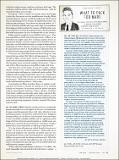| dc.contributor.author | De Weck, Olivier L. | |
| dc.date.accessioned | 2010-03-05T16:26:09Z | |
| dc.date.available | 2010-03-05T16:26:09Z | |
| dc.date.issued | 2009-05 | |
| dc.identifier.issn | 0018-9235 | |
| dc.identifier.uri | http://hdl.handle.net/1721.1/52341 | |
| dc.description.abstract | De Weck, O.L. “What to Pack for Mars.” Spectrum, IEEE 46.6 (2009): 39. © 2009 Institute of Electrical and Electronics Engineers | en |
| dc.language.iso | en_US | |
| dc.publisher | Institute of Electrical and Electronics Engineers | en |
| dc.relation.isversionof | http://dx.doi.org/10.1109/MSPEC.2009.4977609 | en |
| dc.rights | Article is made available in accordance with the publisher's policy and may be subject to US copyright law. Please refer to the publisher's site for terms of use. | en |
| dc.source | IEEE | en |
| dc.title | What to Pack for Mars | en |
| dc.type | Article | en |
| dc.identifier.citation | You can't take much into space. When a rocket is on the launchpad, 99.9 percent of the mass is the fuel and the vehicle itself. That leaves 0.1 percent for everything else the crew and all their supplies. When considering what to bring, how do we trade off between consumables (needed for survival), spare parts (for safety), and research equipment (which gives the mission value)? | en |
| dc.contributor.department | Massachusetts Institute of Technology. Engineering Systems Division | en_US |
| dc.contributor.approver | De Weck, Olivier L. | |
| dc.contributor.mitauthor | De Weck, Olivier L. | |
| dc.relation.journal | IEEE Spectrum | en |
| dc.eprint.version | Final published version | en |
| dc.type.uri | http://purl.org/eprint/type/JournalArticle | en |
| eprint.status | http://purl.org/eprint/status/PeerReviewed | en |
| dspace.orderedauthors | De Weck, Olivier | en |
| dc.identifier.orcid | https://orcid.org/0000-0001-6677-383X | |
| mit.license | PUBLISHER_POLICY | en |
| mit.metadata.status | Complete | |
